Growing up as a kid, my favorite player was Dodgers closer and Cy Young winner Eric Gagne (Yes Franco loves this). I had a Gagne jersey, a Gagne bobblehead, a Gagne poster in my room, heck I even bought the Guns N’ Roses album so I could listen to Welcome to the Jungle (his entrance song) on repeat.
Something about the triple digit fastball and the famous rec specs coming in from the bullpen with “Game Over” flashing on the scoreboard was thrilling to me. This post obviously isn’t about Eric Gagne but about another back-end reliever with a dynamite fastball and today’s version of rec specs- technology and style are a little better today.
I was lucky enough to spend time in Boston earlier in the week where I had the pleasure of watching the Red Sox every night while I was out to dinner. The Red Sox and Yankees had a great game going, with Boston up by a run late in the game.
John Farrell went to a flame throwing righty out of his pen late in the game. This flame-throwing righty was Joe Kelly.
For those of you who don’t remember, Kelly came over to the Red Sox from the Cardinals with Allen Craig in exchange for John Lackey in 2014. At the time, Boston thought they were getting a young starting pitcher with a live arm and some control issues that could be a middle of the rotation starter someday.
Joe Kelly is not a middle of the rotation starter. As a matter of fact, Joe Kelly is not a starter at all anymore, and with good reason.
Something happened in the game Tuesday night that made me even think to write this post, which the great Travis Sawchik already documented the next day: Kelly hit 102.2mph with his fastball, giving him the fastest thrown pitch via Statcast this season.
This post is not about how Joe Kelly is one of hardest throwers in the game, rather how Joe Kelly has become a top reliever in baseball this season.
First, let’s start with a table showing Joe’s first 25 innings pitched of the season for the last 3 years:
| Year | ERA | Strikeouts | Home Runs |
| 2015 | 4.94 | 28 | 1 |
| 2016 | 7.62 | 28 | 4 |
| 2017 | 1.42 | 18 | 0 |
Joe is putting up career best numbers besides strikeouts – the one you would expect for him to drastically increase being a reliever with a triple digit fastball. As I’ve already mentioned, Joe Kelly is throwing harder than ever, his average fastball (98.8mph) is more than two ticks above his fastball from last year (96.3mph). However, Kelly is throwing his fastball less than he did the previous two years.
You read that right: The guy throwing 100 is throwing his slider and curve more than ever! Check out the graph below for Joe’s pitch usage the last three years:
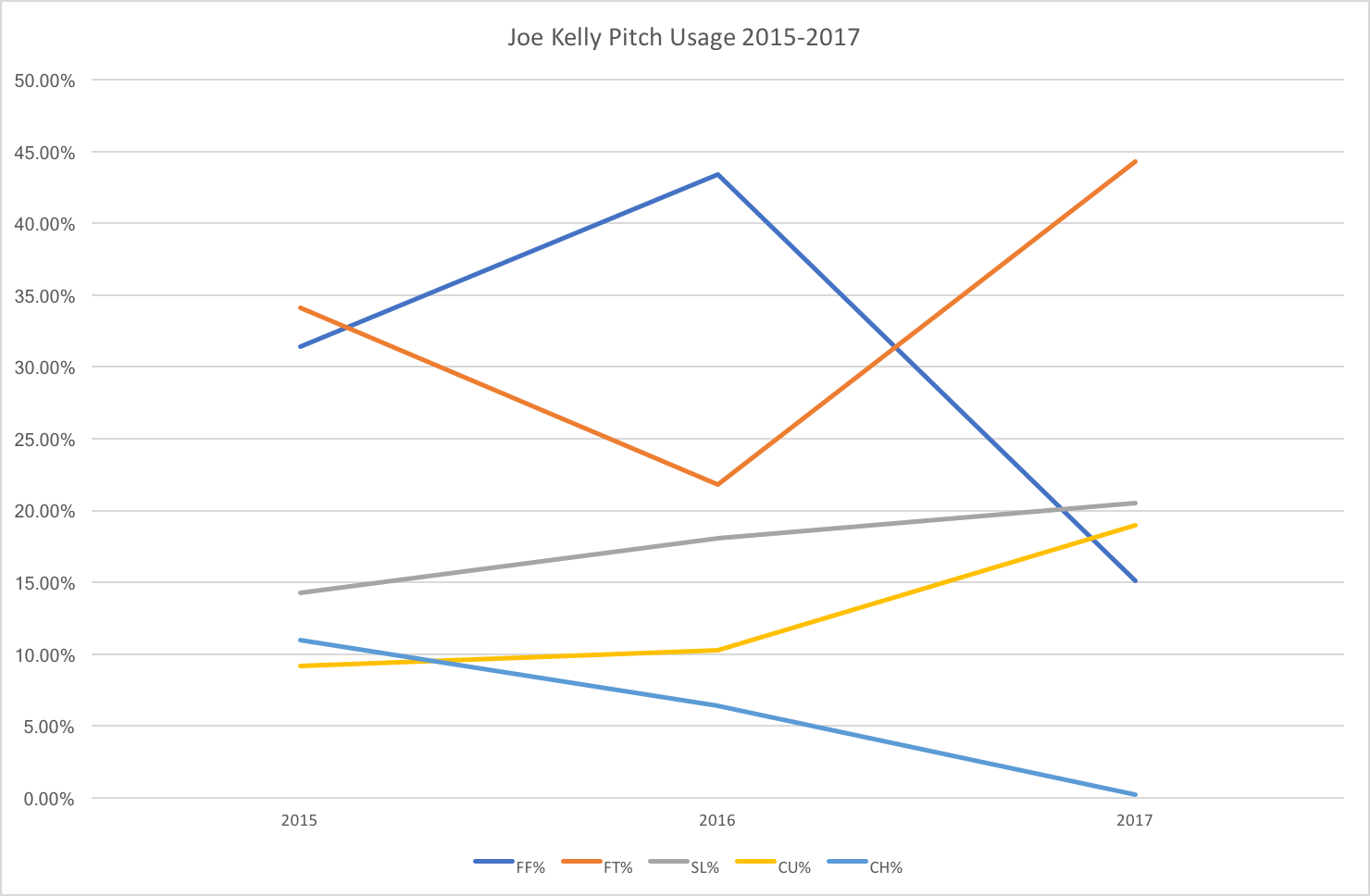
Kelly is throwing more 2-seamers and seems to have completely abandoned his change-up. What’s interesting is Kelly is also throwing his curve more than ever to go along with his slider.
I won’t throw table after table at you, but Kelly’s slider has also gained velocity to go along with his fastball (this really isn’t a surprise to me here). While the break on the pitch has taken a minor hit, the pitch is much sharper now and it appears Kelly is having a much easier time controlling it.
Speaking of one of Kelly’s secondary pitches sacrificing some movement for better control, Kelly is doing the exact same thing with his curveball. He’s also throwing his curve harder than ever and no longer trying to get chases with the pitch. Check out the graph below of Kelly’s curveballs from 2016 to this season:
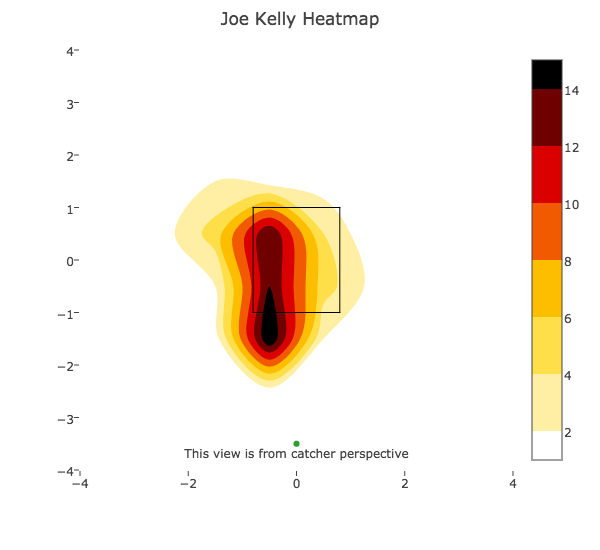
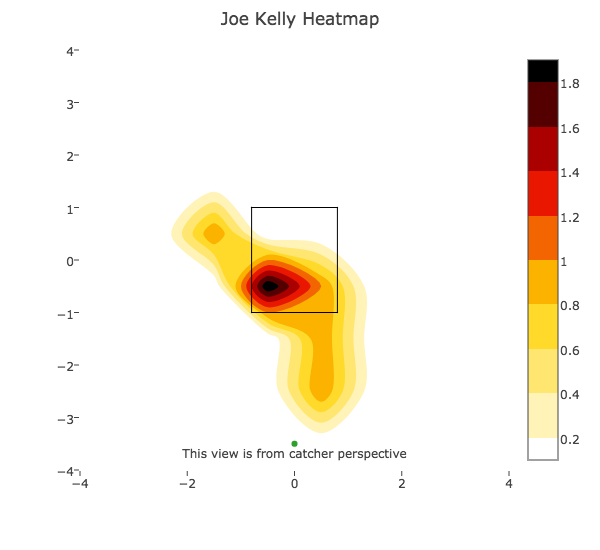
Joe is also experiencing much better control with fastball. Here are the same charts from above only for Kelly’s fastball (I combined four-seam and two-seam for the sake of this article) over the past two seasons:
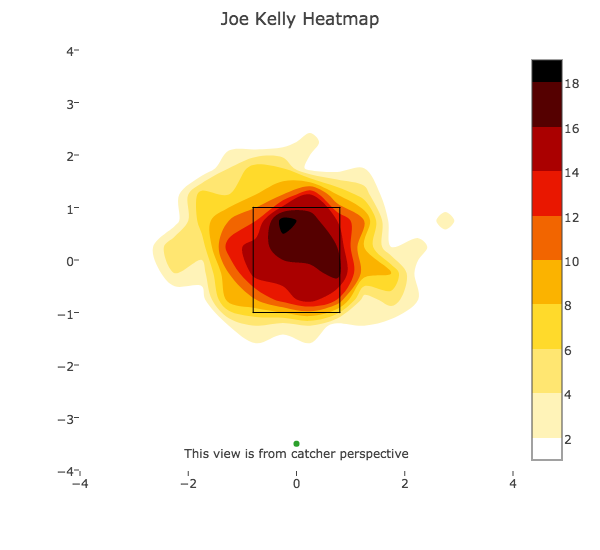
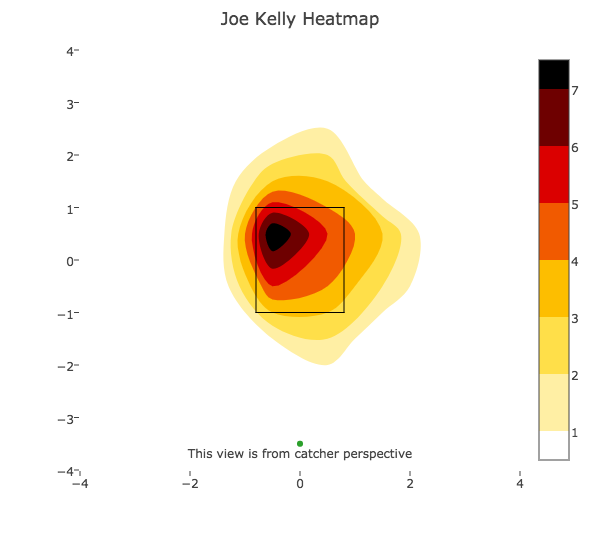
Now, we know Kelly is throwing more two-seamers and we know that two-seamers have arm-side movement or “run”. Looking at the heat map above, it’s a safe guess that Kelly isn’t trying to pinpoint his fastball anymore. He is throwing it over the plate and it is doing what a natural two-seamer does: running towards his arm-side.
Kelly is fine with throwing the pitch in the zone now (oh, the perks of throwing 100mph), along with all his other offerings, and that has made him a completely different pitcher. With stuff as electric as Kelly’s, he can afford to pound the zone and challenge hitters because even if they do hit the ball, it’s hard to square up.
Kelly’s strikeouts are down a bit, but this table should show you why I’m not worried at all:
| Year | GB% |
| 2015 | 45.6% |
| 2016 | 46.9% |
| 2017 | 59.7% |
Joe Kelly was 74th last year among qualified pitchers in ground-ball rate. This year he is 13th. That’s a big difference! Although hitters are making more contact, they are beating Kelly’s pitches into the ground. We all know the league-wide trend of homers and fly balls increasing, so this is a great sign for the Red Sox.
Statcast also tracks a stat called “Barrels”- a metric where a batted ball’s exit velocity and launch angle averages at least .500 batting average and 1.500 slugging. How many “barrels” has Kelly allowed? We are now in the middle of June and Kelly has allowed one, which puts him in a group with arms like Aroldis Chapman and Wade Davis.
Usually we see starters get moved to the pen because they don’t have a third pitch. In this case, Joe is going against the norm and increasing his pitch mix by using his secondary offerings more.
This might make you wonder if Joe might be able to take this new-found approach back to the starting rotation. The starter-reliever-back to starter approach would be interesting and I would be curious to see the results if Boston were ever to go that route.
Regardless of whether Kelly is starting games or helping finish them, he has become an arm to watch this season. Joe Kelly has always had electric stuff. This year, his stuff may be more electric than ever.
It’s cool to see a reliever trust his abilities and not try to miss so many bats. Kelly has realized that it’s not always about missing bats, it’s about missing barrels.



